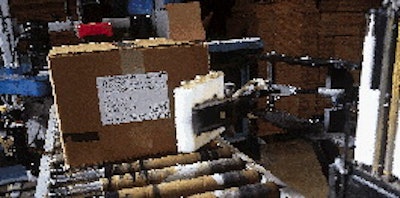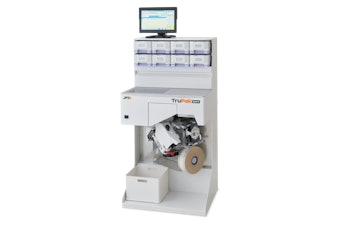Workers at folding carton converter Walter G. Anderson, Inc. used to manually apply preprinted labels to the corrugated cases the company uses to ship knocked-down cartons to its customers. Walter G. Anderson's (WGA) combined labor and label costs, however, proved prohibitive for the Hamel, MN, company.
"We shipped about one million cases last year, with each case holding 250 to 300 cartons," notes Marc Anderson, vice president of manufacturing for the privately held family business. A pressure-sensitive label was manually applied to each shipping case packed on three daily shifts, five days/week. "We used a larger label size in the past, and we had to estimate the number of labels we'd need, rather than print on demand as we do now," he recalls.
By last May, the company implemented changes that it expects will save it more than $100ꯠ/yr. Rather than continuing to order preprinted labels, WGA decided to print labels on demand. To do that, the Minnesota firm added three Paragon front-and-side-panel print-and-apply tamp labeling systems manufactured by Marprint (White Bear Lake, MN). Marprint's owner, Lowry Computer Products (White Bear Lake, MN), served as distributor for the labeling systems. Also added last May were four case tapers from 3M (St. Paul, MN) acquired through distributor Shippers Supply (Minneapolis, MN). Linking the equipment are powered roller conveyors supplied by B&L Fabricating (Shoreview, MN).
Smart savings
WGA prints and die-cuts folding cartons at its 172ꯠ sq' Hamel facility. About half of its customers are in the dry food packaging business. Confectionery and medical products cartons also make up a large part of the converter's customer mix.
Until last spring, WGA used labels preprinted with the company name that were then thermal-transfer-printed with other necessary information. "We were looking to reduce labor and label costs," Anderson recalls. "Now we use smaller-size pressure-sensitive labels that measure six inches wide by four inches high. We no longer have to estimate the number of labels we need, which resulted in wasting labels. Instead, we print them as we need them."
Asked to quantify the cost advantages of on-demand labeling, Anderson says, "We were [paying] around seven cents for a preprinted label. We're down to about four cents per label now. I'm estimating that we'll save about $20ꯠ in labels alone each year."
While the material savings are impressive, WGA's primary savings come from reduced labor costs. By no longer having to manually apply labels to shipping cases, the company was able to reassign the person who performed that task to a different job.
"That amounts to about $35ꯠ a year in savings, and that's just on one shift," Anderson points out. "We run three shifts five days a week." The combined labor and label savings add up to $130ꯠ/yr.
Printing . . .
WGA uses four offset sheet-fed presses to print rolls or sheets of paperboard in thicknesses of 14- to 36-pt. After printing, the board is die-cut and scored, with trim scrap removed. The blanks are side-seam glued on one of four folder/gluers. Operators then place cartons into manually set-up cases.
Three of the four gluers are equipped with Marprint Paragons. The fourth line, Anderson says, runs specialty case sizes. Because this line runs more slowly than the other three, he says it was more economical to print labels on an older thermal-transfer unit and apply them manually to cases than to invest in a fourth new print-and-apply system.
When asked about WGA's relationship with Marprint, Anderson says, "We had worked with them before. We investigated what equipment would work best for us and made the decision to use Marprint's print-and-apply labeler."
The print engine for this application is from Zebra Technologies (Vernon Hills, IL). It thermal-transfer-prints WGA's customer name, item, item number, purchase order, quantity of cartons in the case, and a case identification number and bar code, if requested. WGA employees generate the appropriate information on a computer that downloads the information to the printer.
. . . and applying
Once the label is printed, usually in black, vacuum is used to hold it in place on a flexible arm. As the filled case passes a photoeye just upstream of the Paragon, it signals the arm to apply the p-s label to either the front or to the side of the case. Placement is determined by customer preference.
Afterwards, the labeled case is p-s taped across its top and bottom. Taping is done on a 3M Matic Model 800a side belt adjustable semi-automatic machine. Like the Marprint units, Anderson says, "We've used 3M tapers before, and they've worked well for us." The four machines were added at the same time as the labelers.
A case taper was added to all four lines so that taping would be conducted at this stage of the line. In the past, case taping was done downstream near manual palletizing, which Anderson says slowed production.
Taped cases from each line merge onto a single conveyor line that leads to downstream palletizing and stretch wrapping. "We had a whole new conveyor system installed for this project," says Anderson. "We worked closely with B&L, a local company that did a good job for us." B&L estimates that it installed about 120' of powered roller conveyor at WGA, as well as the complete PLC control system for it.
Summarizing the project, Anderson says, "We made changes and added the machinery to improve our manufacturing flow and reduce our costs. We took a simple idea and made it work."



















